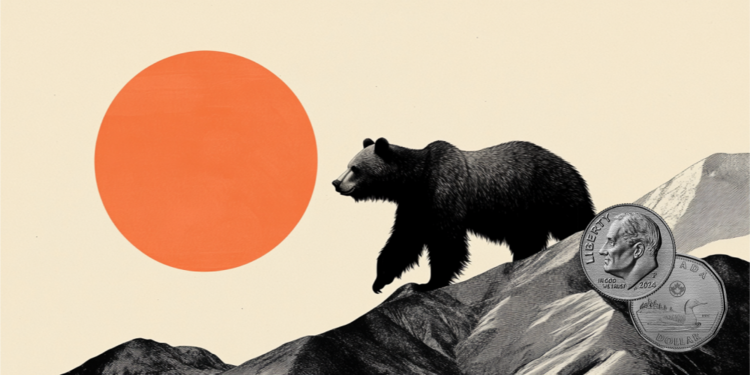- USD/CAD reverses an early decline to 1.3700, although upside potential appears limited.
- US political uncertainty and dovish Fed bets keep USD bulls on the defensive.
- The rebound in oil prices benefits the Canadian dollar and helps limit the pair’s gains.
The USD/CAD pair is attracting some buying following a rally in the Asian session towards the 1.3700 area, though it lacks follow-through and remains below a near three-week low touched on Friday. Spot prices are currently trading around the 1.3725-1.3730 region, unchanged on the day, and the directionless intraday price movement is sponsored by a combination of divergent forces.
The initial market reaction to US President Joe Biden’s exit from the presidential race turned out to be short-lived, as evidenced by a modest rebound in the US Dollar (USD). This turns out to be a key factor acting as a tailwind for the USD/CAD pair. That said, dovish Federal Reserve (Fed) expectations restrain traders from placing aggressive bullish bets on the Dollar and limit the upside of the currency pair.
Investors now seem convinced that the US central bank will cut borrowing costs in September and have been pricing in two more rate cuts by the end of the year, which is anticipated to boost economic activity and boost demand. This helps crude oil prices reverse some of Friday’s sharp losses to a one-month low, benefiting the commodity-linked Canadian dollar and helping to keep a lid on the USD/CAD pair.
Meanwhile, concerns over an economic slowdown in China, the world’s largest oil importer, are expected to act as a headwind for crude oil prices. Traders also seem reluctant and prefer to wait for more clues on the Fed’s policy path before opening directional positions around the USD/CAD pair. Therefore, the market’s attention will remain focused on the US Personal Consumption Expenditure (PCE) Price Index data, due out on Friday.
Market participants will also be faced with the release of preliminary PMIs this week, which should provide fresh insight into the health of the global economy and influence crude oil prices. Meanwhile, broader risk sentiment could continue to boost the USD and create short-term trading opportunities around the USD/CAD pair in the absence of any relevant market-moving macroeconomic data from either the US or Canada.
Canadian Dollar FAQs
The key factors determining the Canadian dollar (CAD) are the level of interest rates set by the Bank of Canada (BoC), the price of oil, Canada’s main export, the health of its economy, inflation and the trade balance, which is the difference between the value of Canadian exports and its imports. Other factors include market sentiment, i.e. whether investors are betting on riskier assets (risk-on) or looking for safe assets (risk-off), with risk-on being positive for the CAD. As its largest trading partner, the health of the US economy is also a key factor influencing the Canadian dollar.
The Bank of Canada (BoC) exerts significant influence over the Canadian dollar by setting the level of interest rates that banks can lend to each other. This influences the level of interest rates for everyone. The BoC’s main objective is to keep inflation between 1% and 3% by adjusting interest rates up or down. Relatively high interest rates are generally positive for the CAD. The Bank of Canada can also use quantitative easing and tightening to influence credit conditions, with the former being negative for the CAD and the latter being positive for the CAD.
The price of oil is a key factor influencing the value of the Canadian dollar. Oil is Canada’s largest export, so the price of oil tends to have an immediate impact on the value of the CAD. Generally, if the price of oil rises, the CAD rises as well, as aggregate demand for the currency increases. The opposite occurs if the price of oil falls. Higher oil prices also tend to lead to a higher probability of a positive trade balance, which also supports the CAD.
Although inflation has traditionally always been considered a negative factor for a currency, as it reduces the value of money, the opposite has actually occurred in modern times, with the relaxation of cross-border capital controls. Higher inflation typically leads central banks to raise interest rates, which attracts more capital inflows from global investors looking for a lucrative place to store their money. This increases demand for the local currency, which in Canada’s case is the Canadian dollar.
The released macroeconomic data measures the health of the economy and can have an impact on the Canadian Dollar. Indicators such as GDP, manufacturing and services PMIs, employment and consumer confidence surveys can influence the direction of the CAD. A strong economy is good for the Canadian Dollar. Not only does it attract more foreign investment, but it can encourage the Bank of Canada to raise interest rates, which translates into a stronger currency. However, if the economic data is weak, the CAD is likely to fall.
Source: Fx Street
I am Joshua Winder, a senior-level journalist and editor at World Stock Market. I specialize in covering news related to the stock market and economic trends. With more than 8 years of experience in this field, I have become an expert in financial reporting.







